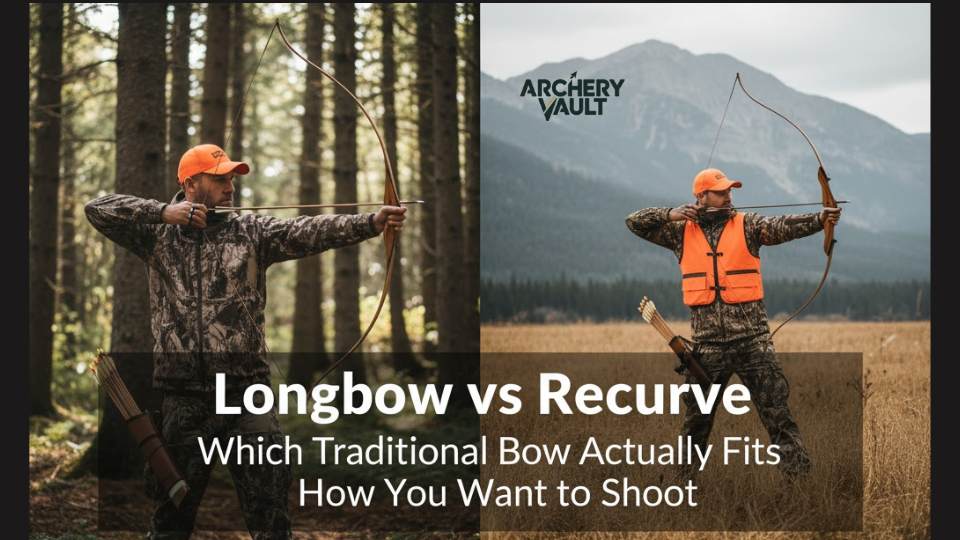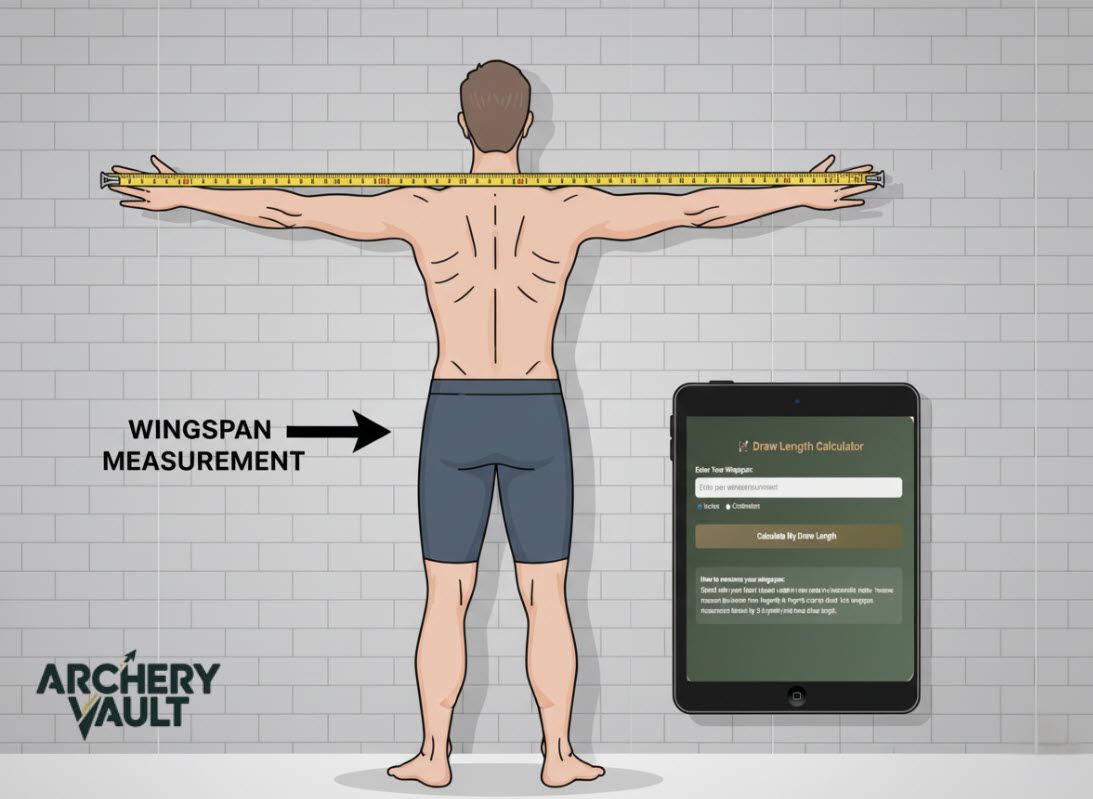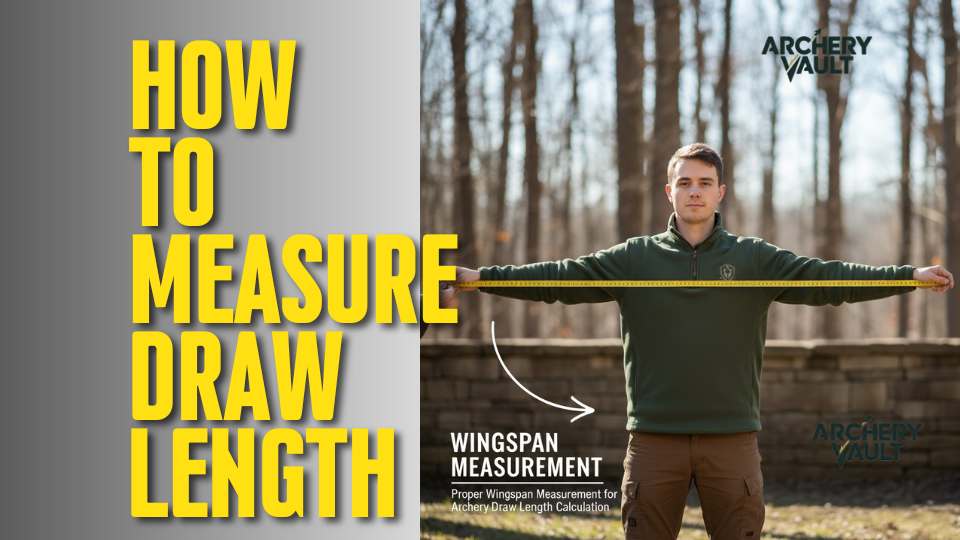I’ve watched new archers agonize over this decision for weeks, reading forum threads from 2009, asking everyone at the range, trying to logic their way into the “correct” choice. Here’s what nobody tells you up front: you’re probably overthinking it.
Both longbows and recurves will teach you to shoot. Both are traditional bows without training wheels. Both will frustrate you at first and then suddenly click one day when your form comes together. The real question isn’t which bow type is “better” – it’s which matches what you actually want to do with it.
The Shape Difference Actually Matters
A longbow is basically a bent stick. Serious oversimplification, but that’s the idea – one smooth curve from tip to tip in a D-shape. The string only touches at the nocks. Traditional English longbows are tall (sometimes taller than you), usually one piece of laminated wood, and they look exactly like what you’d see in a medieval painting.
Recurve bows have those curved tips that bend back toward you when the bow is strung. That’s where the name comes from – the limbs recurve away from the archer. Most modern recurves are takedown models with a metal riser and bolt-on limbs. Some are one piece, but those are less common now.
That tip curve isn’t just aesthetic. It fundamentally changes how the bow stores and releases energy, which affects everything else about shooting it.
Draw Cycle: Why Longbows Feel So Damn Smooth
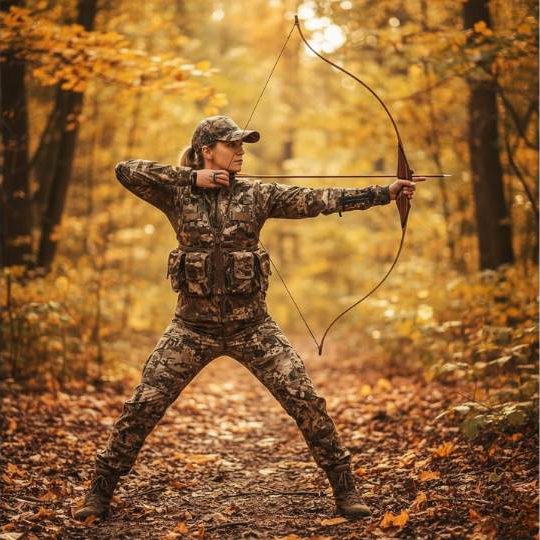
The best thing about longbows? The draw is like butter. Smooth, steady, predictable from start to finish. No surprises, no weird stacking at the end. You just pull to anchor and it feels natural the whole way.
Recurves stack. Especially cheaper ones. That last inch or two of draw gets noticeably heavier because you’re pulling against those curved tips. It’s not terrible on quality recurve designs, but it’s there. Some people hate it. Others don’t even notice after a while.
I know guys who switched from recurve to longbow purely because they got tired of that stacking feeling on long practice sessions. I also know recurve shooters who think longbow guys are just being dramatic about it. Try both if you can. Your opinion matters more than anyone else’s on this.
Speed and Power: Recurves Win, Period
A recurve bow launches arrows faster than a longbow at the same draw weight. Not a little faster – we’re talking 10-15 fps difference, sometimes more. Those curved tips store extra energy that gets dumped into the arrow.
For target shooting at known distances, that speed difference doesn’t matter much. For hunting or 3D archery where you’re estimating range? It matters. Faster arrows drop less, which gives you more margin for error on distance calls. Check your arrow speed with different setups – the difference is real.
Longbow shooters will tell you speed isn’t everything. They’re right. But if you’re hunting and you want the flattest possible trajectory, recurves deliver more performance per pound of draw weight. Physics doesn’t care about tradition.
Accuracy: Recurves Win Again (But Maybe You Don’t Care)
Modern takedown recurves are more accurate than longbows. That’s just mechanical reality. The Samick Sage recurve bow is more consistent than any traditional longbow because you can tune it, the riser dampens vibration better, and the limbs are engineered for repeatability.
Olympic archers shoot recurves, not longbows. Tournament winners shoot recurves. If maximum accuracy is your goal, get a recurve.
But here’s the thing – some of us don’t care about being Olympic-level accurate. Traditional archery isn’t always about scores. Sometimes it’s about shooting a simple wooden bow the way archers did for centuries. A longbow makes you work for accuracy, and when you finally start grouping tight, it feels earned in a way recurves don’t.
Which Is Easier to Learn?
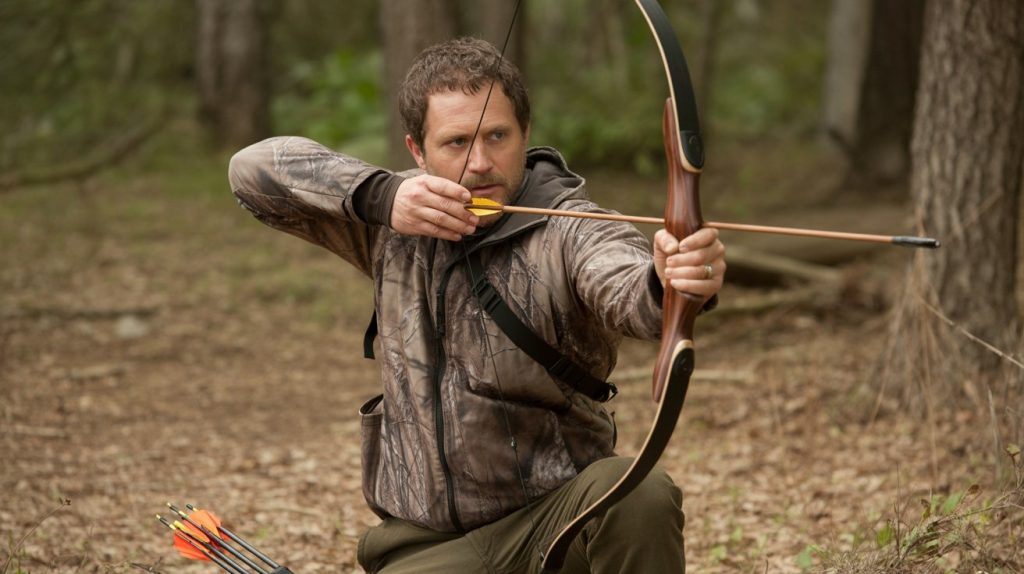
Recurves forgive more mistakes. The limb design reduces hand shock. Takedown models let you start light and add draw weight as you improve. Modern recurves like the Bear Grizzly recurve bow bridge traditional aesthetics with forgiving performance – you get that classic look without fighting a brutally unforgiving bow.
Longbows slap you when you screw up. Literally sometimes, if your bow arm position is wrong. There’s more hand shock, more string slap risk, and the slower arrow makes aiming errors more obvious. They’re harder to shoot well.
That’s exactly why some people prefer them. A longbow demands good form. You can’t muscle through it or rely on the bow to compensate for sloppy technique.
For your first bow, get a takedown recurve. Build good habits with something forgiving, then switch to a longbow later if you want the challenge. Going the other way – learning on a longbow first – just means you’ll probably get frustrated and quit before the fun part starts.
Portability: Takedowns Win, Obviously
My recurve breaks into three pieces and fits in a backpack. My buddy’s one-piece longbow requires a 6-foot bow case or he has to strap it to his roof rack. Travel much and you’ll understand why takedown recurves dominate.
ILF (International Limb Fitting) standard means you can swap limbs between different risers. Break a limb on your Samick Sage recurve? Throw on replacement limbs and keep shooting. Try that with a one-piece longbow.
Some companies make takedown longbows now. They’re a nice middle ground if you want that smooth longbow draw but need practical portability. They cost more though, and purists will tell you they’re not “real” longbows. Whatever. Shoot what works for your situation.
The Sound Difference (It’s Real)
Longbows are quieter. That soft “thock” sound vs the sharper crack from a recurve. If you’re hunting or shooting in your backyard where neighbors might complain, longbows make less noise.
Recurves smack. Those curved tips releasing stored energy creates vibration and noise. You can add dampeners and stabilizers, but a bare recurve will never be as quiet as a comparable longbow.
Not a huge deal for target shooting. Matters if you’re trying to be stealthy.
Cost Reality Check
Decent entry recurves start around $150-200. The Samick Sage recurve bow is like $140 and it’s legit. Mid-range recurves run $300-600. You can spend $1000+ on high-end Olympic risers if you’re into that.
Traditional longbows start around $300-400 for factory models. Custom longbows from respected bowyers run $800-1500+. You’re paying for hand-crafted work and carefully selected wood.
Recurves have way more options at every price point. Longbows are more niche, so selection is limited unless you’re shopping custom makers.
What Should You Actually Buy?
Get a takedown recurve if you want versatility and the easiest learning curve. They’re practical, forgiving, widely available, and you can use them for everything from backyard target practice to hunting. Most archers should start here.
Get a longbow if you’re specifically drawn to traditional archery for its own sake, you appreciate simplicity, and you’re okay with a steeper learning curve. Longbows are more challenging and more rewarding when you finally shoot them well.
Or don’t stress about it too much. Both bow types will teach you proper form. Both connect you to stick-and-string shooting in ways compounds never will. Whichever one you choose, you’ll probably end up buying the other type eventually anyway once you get hooked on traditional archery.
Frequently Asked Questions
What draw weight should I start with for a recurve bow?
Start with 20-25 pounds if you’re an adult learning traditional archery. Seriously. I know that sounds light, but you’re building form and muscle memory, not trying to impress anyone at the range. Shoot 20-25 lbs for a few months, get your form solid, then move up to 30-35 lbs. Most adult men end up around 40-50 lbs for hunting. Women often settle around 35-45 lbs.
The biggest mistake new archers make is buying too much draw weight too soon. You develop bad form trying to muscle back a bow that’s too heavy, and those habits stick. Start light with a takedown recurve like the Samick Sage so you can swap heavier limbs on later as you progress.
Can you hunt deer with a recurve bow?
Yes, absolutely. Most states allow recurve bow hunting for deer with minimum draw weight requirements, typically 40 pounds or higher. Check your specific state regulations – some require 40 lbs minimum, others want 45+ lbs. For ethical kills on whitetail, you want at least 40 lbs of draw weight with a well-tuned arrow setup that delivers sufficient kinetic energy to the target.
Recurves are actually excellent hunting bows. They’re quieter than compounds, more compact than longbows, and plenty powerful for deer-sized game. Just practice extensively at realistic hunting distances (20-30 yards max for most traditional archers) and know your effective range before hunting season.
Do you need a glove or tab for recurve and longbow shooting?
Yes, get a shooting glove or finger tab. Don’t try shooting bare fingers unless you enjoy blisters and string slap pain. A leather shooting tab or three-finger glove protects your fingers from the string and gives you a consistent release point. Most traditional archers prefer tabs because they’re simple and don’t affect your draw hand feel as much as bulky gloves.
Tabs cost $10-20. Gloves run $15-30. Either works fine. Try both and see which feels better for your shooting style. Some people find gloves more comfortable for long practice sessions. Others prefer the minimal feel of a tab. Just don’t skip finger protection entirely.
Are recurve bows harder to shoot than compound bows?
Much harder. Compound bows have let-off (usually 70-80%), meaning you’re only holding 15-20 pounds at full draw even on a 70-pound bow. Recurves have zero let-off. Draw a 45-pound recurve and you’re holding 45 pounds the entire time you’re aiming. That requires significantly more back and shoulder strength.
Recurves also lack sights, stabilizers, and all the accuracy aids compounds have (unless you add them, which defeats the traditional archery purpose for most shooters). Your form has to be perfect. Anchor point, release, follow-through – everything matters more because there’s nothing compensating for mistakes. But that’s exactly why traditional archery is rewarding. Check out our guide on choosing arrows for a compound bow if you’re comparing setups.
What is the 5/8 rule for longbows?
The 5/8 rule is a rough guideline for picking longbow length based on your draw length. Take your draw length and divide by 5/8 (or multiply by 1.6) to get minimum recommended bow length. So if you draw 28 inches, you want at least a 67-68 inch longbow. Go shorter and you risk excessive stacking at full draw and stress on the limbs that can lead to failure over time.
It’s not a hard rule that you absolutely must follow – plenty of people shoot shorter longbows without problems – but it’s a safe starting point, especially for beginners who don’t know their preferences yet. Longer longbow limbs generally mean smoother draw cycles and less stress on the wood.
Key Things to Remember:
- Recurves shoot faster, forgive more mistakes, and offer better accuracy potential than longbows
- Longbows have smoother draw cycles and quieter shots but are harder to master
- Takedown recurves are the most practical first bow for versatility and adjustability
- Traditional longbows appeal to archers who value authenticity and simplicity over performance
- Both bow types teach proper archery form and connect you to traditional shooting
- Try both if possible before buying – personal preference matters more than “better” or “worse”
Which one are you leaning toward?

